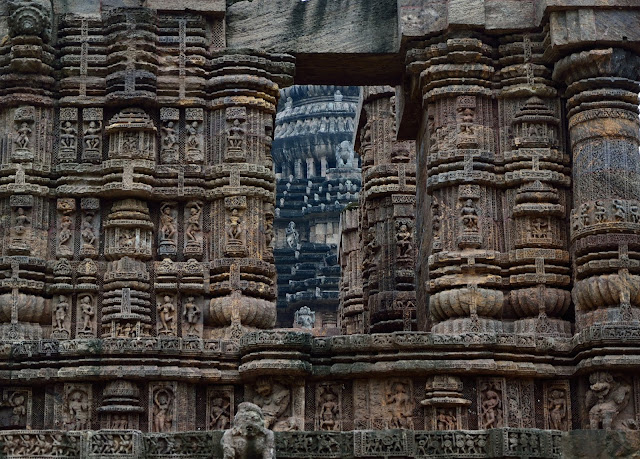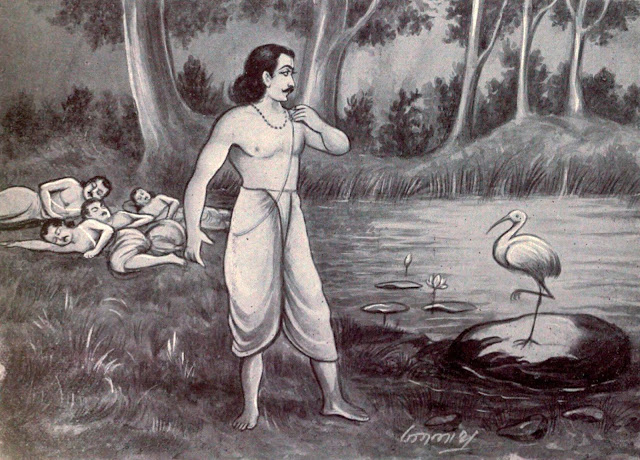Week 14 Story Lab
I am using this last Story Lab to follow up with various information
I gathered through the research I performed for my Storybook: The Konark
Dialogue
The Konark Temple has an origin story based on the story of Dharmapada,
the chief architect's son.
Dharmapada Story Information:
- · The construction work of Sun Temple of Konark was overseen by Sibei Samantray Mahapatra and Bishu Maharana as the chief architect.
- · Sibei Samantray was blessed by Goddess Ramchandi for this work.
- · The condition of the soil where the temple was to be erected, originally was so bad, that the chief architect, Bishu Maharana, who was entrusted with the work, became upset.
- · Sanctity of place mandated that the temple be built on the site it is built on today
- · There was a contract between the king and workers, that no one will be allowed to go away until the whole work was completed.
- · With construction nearing completion, chief architect Bisu Maharana and his workers faced the difficulty of installing the Amalaka (Kalasha) (temple crown stone)
- · 12 year old son visits the construction site.
- · Bishu Maharana conveyed to his son that he was not able to install the Amalaka (Kalasha) properly.
- · The boy immediately climbed to the top and discovered something wrong in the work. He discovered the defect and directed the Kalasha into its proper position.
- · The workers were shamed that a young boy was able to solve the engineering dilemma and feared that the king would suspect that they had not been doing their job competently. They still feared the king would kill them.
- · The boy, not wanting fame for his accomplishment and empathizing with the construction workers, climbed to the top of the temple and dove into the ocean to sacrifice his life.
Miscellaneous Indian temple information:
·
The main temple structure and the geometrical
patterns all around the temple.
·
The carved wheels and the spokes of the wheel
which serve as sun dials.
·
Architectural figures including the war horses,
the elephants and the guarding lions at the entrance.
·
The Nata Mandir (Dancing Hall).
·
Three images of Sun God at three direction of
the temple to catch the rays of the Sun at dawn, noon and sunset.
·
The various images of deities, dancers,
musicians, elephants and mythical creatures.
·
The second level of the temple structure which
showcases the famous erotic sculptures.
·
The Sun temple museum run by Archaelogical
Survey of Indian.
·
The Nava Graha (Nine Planets) Temple.
·
Konark temple was initially built on the sea
bank but now the sea has receded and the temple is a little away from the
beach. This temple was also known as 'BLACK PAGODA' due to its dark color and
used as a navigational landmark by ancient sailors to Odisha.
·
Everyday, the Sun's rays would reach the Nata
Mandir from the coast and reflects from the diamond placed at the center of the
idol.
·
A heavy magnet was placed at the temple top and
every two stones of the temple is sandwiched by iron plates. The idol was said
to have been floating in air due to the arrangement of magnets. The magnet at
the top is said to have disturbed compasses for coastal voyagers and later
removed.
Paper
The information below is copied from the Infinity Foundation
Website. See link below.
- Wooden board: - About 5th century BC the wooden board was used for writing purposes. Writing on it could be done with a piece of chalk (pandu-lekha). This method was used for teaching. Al-Biruni, the great Arabian medieval scholar, also writes, "The (the Hindus) use black tablets for the children in the school and write upon them along the long side, not the broad side, writing with a white material from the left to the right".
- Birch-bark: - The inner bark of bhurja (Betula spp.) tree was the most popular material for writing manuscripts, especially in northern-western India. Al-Biruni informs, "In central and northern India, people use the bark of the tuz tree, one kind of which is used as a cover for bows. It is called bhurja. They take a piece, one yard long, and as broad as the outstretched fingers of the hand, or somewhat less, and prepare it in various ways. They oil and polish it, so as to make it hard and smooth and they write on it."
- Palm-leaves (tada-patra): - In southern India, palm-leaves tada or tala or tali were widely used for writing manuscripts. Al-Biruni has observed, "The Hindus have, in the south of their country, a slender tree like the date and coconut palms, bearing edible fruits and leaves of the length of one yard and as broad as three figures, one put beside the other. They call these leaves tati and write on them… They bind a book of these leaves together by a cord on which they are arranged, the cord going through all the leaves by a hole in the middle of each…They write the title of a book at the end of it, not at the beginning".
- Leather: - Leather was rarely used as writing material in India, but in early and medieval times is was predominant in western Asia and Europe. Al-Biruni also notes, "The Hindus are not in the habit of writing on hides, like the Greeks in ancient times".
- Cloth: - Smooth and non-porous cotton cloth was also used as writing material in ancient India. Nearchos (4th centaury BC), an admiral of Alexander's fleet, was the first to mention that the Indians used to write letters on well-beaten cotton cloth.
- Paper: - Paper, as a writing material, was hardly known in India before the 11th century AD. Al-Biruni writes, "it was in China that paper was first manufactured, Chinese prisoners introduced the fabrication of paper in Samarkand, and thereupon it was made in various places, so as to meet the existing want".
· Paper In India
- The Chinese prisoners of war, brought to Samarkand after the battle of Atlakh near Talas, first introduced (AD 751) the technique of papermaking from linen, flax or hemp rags based on methods used in China.
- Ibn Nadim observed in Al-Fihristi: "The Chinese write on Chinese paper made from a sort of herbage. This (industry) is a great source of income for the city. The Arabs learnt the technique of paper-making from the Chinese captives at Samarkand and diffused it westward". Al-Biruni also stated, "The Chinese captives introduced it in Samarkand whence it diffused to other parts of the world".
- After the paper technology reached the Arabs, the Arabians improved the technique and supplemented linen with flax and other vegetable fibres. With the conquest of Sind by the Arabs, Khurasani paper was first introduced in India early in the eighth century AD, and it continued to be imported for several centuries.
- The reference to Indian paper suggests that the paper-making industry, however limited, had already been established in India, most probably in Delhi and Lahore, the two chief political and cultural seats of the Sultanate period.
- In India, the first paper industry was developed in Kashmir, established by Sultan Zainul Abedin (Shahi Khan) of Kashmir in 1417-67 AD. Actually his father Sultan Sikander (c.1386-1410) was ruling over Kashmir at the time of Timur's invasion of India (AD 1398). Sultan Sikander sent an embassy, led by his son, Shahi Khan, to that formidable personage and sought his friendship. Timur summoned him for a meeting but in the meanwhile political developments at home compelled him to leave India. He hastened to Samarkand but took along Shahi Khan and kept him virtually as a hostage until his death. Shahi Khan returned to Kashmir with many artisans and persons skilled in various trades with a view to introducing new industries there. These included paper-makers, bookbinders, harness-makers and midwives. The author of Tarikh-i-Kashmir stated the following about Shahi Khan, "During his stay at Samarkand he acquired knowledge. When he returned to Kashmir he brought with him a number of artisans skilled in different trades such as paper-makers, book-binders, carpet-makers, harness-makers and well trained midwives."
- Soon, because of its quality, the Kashmiri paper was much in demand in the world and the rest of the country for writing manuscripts. According to Tarikh-i-Farishta, "Sultan Abu Said sent fine Arab horses and strong camels of good breed as presents to Sultan Zainul Abedin. Pleased with this act of courtesy, Sultan Zainul Abedin in return, sent saffron, paper, musk, perfumes, rose-water, vinegar, elegant shawls, glass bowls and other fine products of Kashmir industry".



Comments
Post a Comment